| 1 | Red-tailed green ratsnake |
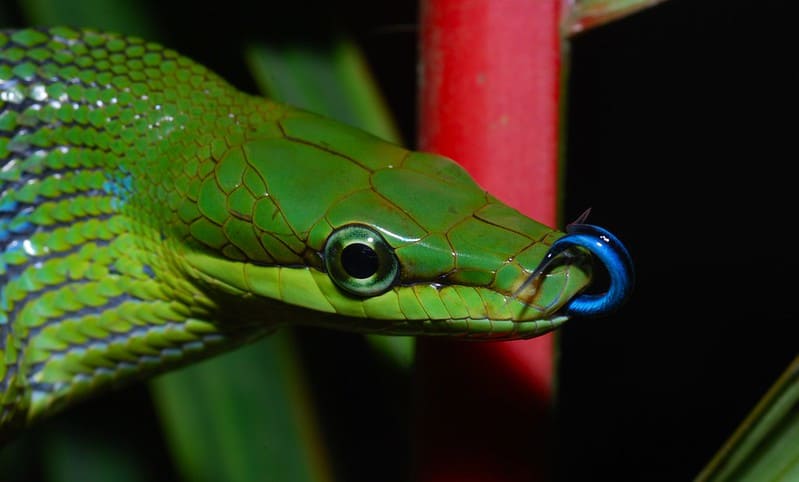
The red-tailed green ratsnake is a 160-200cm species found in forests of Malaysia and Indonesia. They’re arboreal, living on branches, and have only a mild venom. Gonyosoma oxycephalum is dangerously exposed on its branches, and therefore they must seek alternative survival methods.
As its enemy closes in and its heart pounds away, the Gonyosoma oxycephalum keeps its face steady and performs a simple action: it reveals its tongue. This is one of the most distinctive in the snake kingdom, with a vivid blue stripe contrasting against black. Simultaneously, Gonyosoma oxycephalum inflates its chest to reveal blue patches between its scales.
This sudden flash of alien colour is instantly shocking to an approaching predator. It would even shock most humans, causing us to instinctively flinch, despite being able to rationally assess that it’s just a harmless warning display. To a hawk, which doesn’t have the added skill of logic (that we know of), the blue must send all their alert systems into overdrive. The hawk flees and the red-tailed green ratsnake lives to fight another day. This scheme likely fails too – the exact success rate has never been studied in the wild.
| 2 | Cottonmouth |
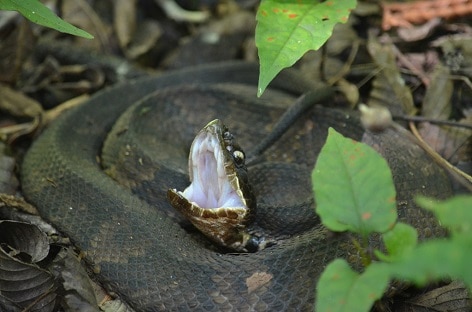
Cottonmouths do exactly what they warned they would: they bare their mouth to reveal a snowy white inside, which is the colour of cotton wool, with no patterns, contrasting vividly against a black mamba’s purple mouth. Their cousin the copperhead has a fleshy pink mouth lining. The cottonmouth’s goal is to frighten predators away, and in their southern US swamp habitats, their predators are plentiful. They include alligators, snapping turtles, blue herons and whooping cranes.
A greedy heron could spot a murky brown snake, and wade over excitedly, thinking it’s found a tasty brown watersnake (a species which coexists with cottonmouths). Suddenly, they see the flash of white which reveals their foolish mistake, and the heron flees to the opposite shore amid a piercing hiss.
Cottonmouths measure 65-90cm, and range from Texas to Louisiana to Florida. This tendency proves that legends of their murderous personality are exaggerated. Do cottonmouths really chase fishermen from boats, follow them through boathouses, and slam into car doors as their victim closes it at the last minute? No – they’d rather warn you with a vivid white mouth, and not enter the chase. Cottonmouths have a cytotoxic venom that causes local effects like severe swelling, but rarely fatalities.
| 3 | Brown vine snake |

A mildly venomous tree snake, which is extremely widespread, ranging from Mexico to Trinidad. Brown vine snakes measure 1.5 metres, but are incredibly thin, skirting over the flimsiest of branches without snapping them. They can fasten a prehensile tail to branches and dangle down, plucking up prey species like anoles.
The one thing Oxybelis aeneus wishes it has is a powerful venom, but they combine several more imaginative strategies in order to compensate. First is kinking their body to resemble a gnarly piece of vegetation, and swinging in the breeze. This actually had nothing to do with their vine title – they were named from the pre-existing green vine snake. Second is a flash of bright warning colour, as like a cottonmouth, they bare their mouths wide open, but with a rich purple-brown colour instead of white.
The impression is of a lethal, finely tuned rainforest venom flowing every fold of their mouth, completely false but highly convincing. Brown vine snakes look completely crazy while flashing these colours, and they don’t rest on their laurels. They combine the display with a piercing hiss and a tight S-coil, as though a life-ending strike is imminent.
| 4 | Caatinga coral snake |
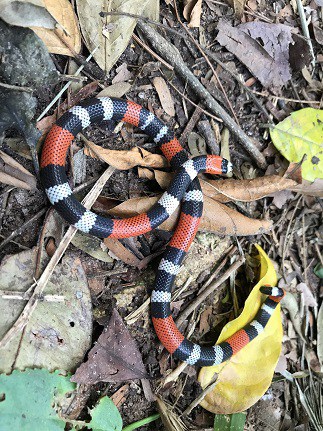
No article about flashy warning colours would be complete without a coral snake. While vipers are a complex grey-brown to blend with forest mulch, coral snakes are the opposite: they wish to broadcast their presence to the whole world. The Caatinga coral snake inhabits eastern Brazil, reaches 147cm, and has the classic red-white-black bands shared by dozens of coral snake species. Their goal is to give predators a chance to reconsider. Micrurus ibiboboca has a classic coral snake venom, with neurotoxins that trigger paralysis, plus bonus symptoms like chest pain and heavy sweating. They’re generally found on forest floors, occasionally agricultural fields next door to them.
It isn’t just bright colours that terrify predators. It does down to the more specific level of alternating red-black-white bands, sometimes yellow instead of white. The local birds and rival snakes have had millions of years to evolve alongside coral snakes, allowing subtle physical signs to fully engrain themselves in their evolutionary databases, and act as an early warning system. With up to 85 Micrurus members, they’ve had plenty of material to study. In extreme eastern Brazil, you have the Caatinga coral snake. In Ecuador to the west, you have the anchor coral snake.
The coral snake’s widespread fear recognition has trigger the phenomenon of coral snake mimics, which copy the red-white-black bands, granting them a safety shield, despite being harmless. Such species include the false tree coral and broadhead ground snake.
| 5 | Wall’s bronzeback |
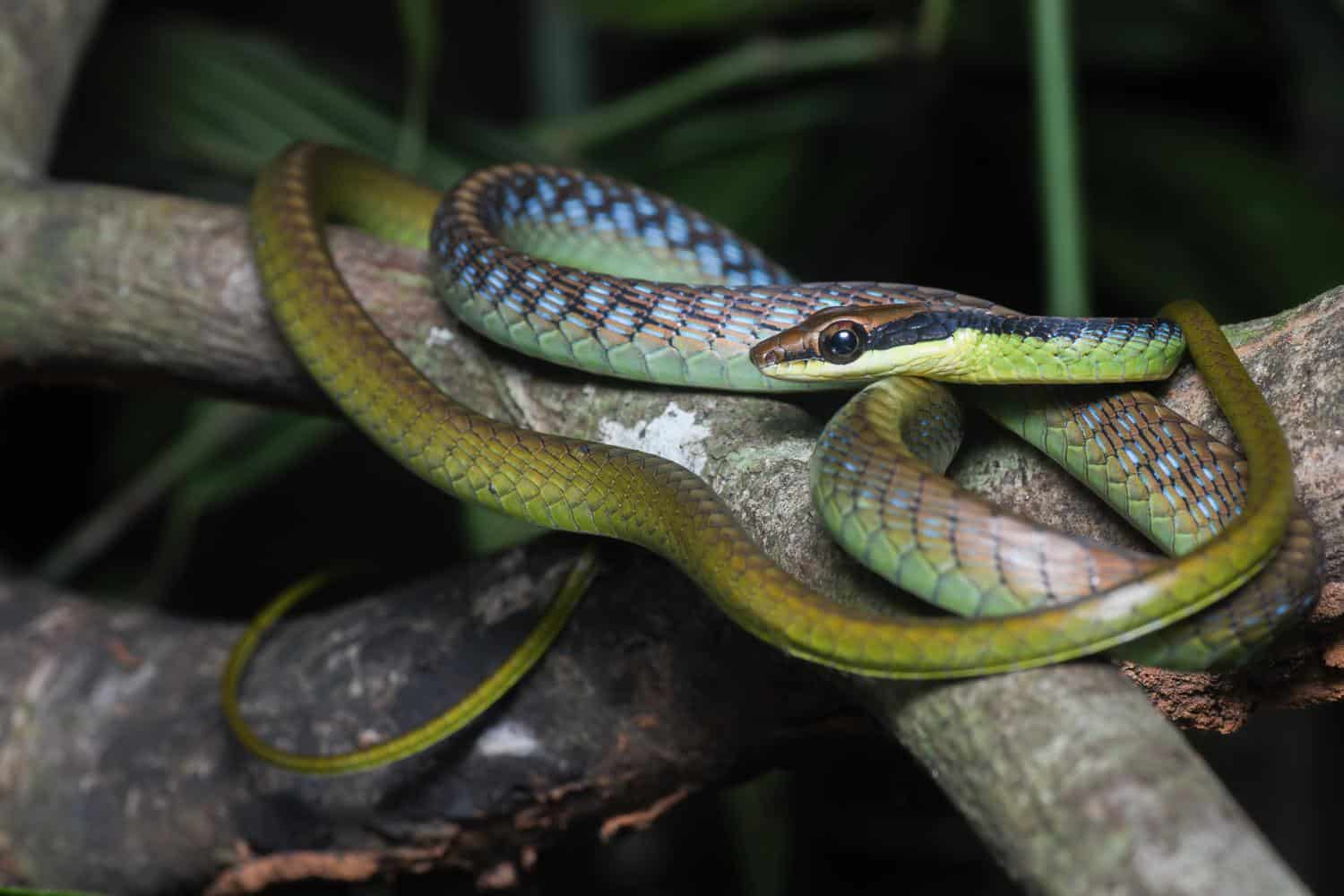
This branch-loving snake inhabits southern Thailand, peninsular Malaysia, and Borneo. They have a mild venom, but even hospitalising someone would be a fluke beyond flukes. Wall’s bronzebacks have a bronze head, a creamy-green belly, a black stripe between, and finally, blue skin which is clearly visible beneath.
Dendrelaphis cyanochloris is commonly confused with its cousin the elegant bronzeback, which also has electric blue patches. But the blue is far more encompassing in Wall’s bronzeback, and they’re much more inclined to blast predators with the bright colours, stunning them momentarily, then sending them fleeing. Wall’s bronzeback has blue visible constantly, but during pressure points, they’ll inflate their chest to spread their scales apart, revealing more of the interstitial skin between them.
The likes of painted bronzebacks barely have this power, despite being more common in Thailand. Perhaps the painted bronzeback has slightly superior speed and agility, ensuring their survival, but Wall’s bronzebacks benefit from their blue-blasting intimidation tactics, giving them a safety buffer against predators. Wall’s bronzebacks prey on frogs and lizards, and have especially large eyes.
| 6 | Yellow-throated garter snake |
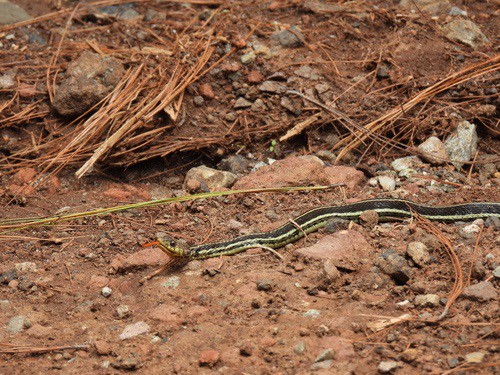
Thousands of miles away, we have another harmless snake that relies on bright blue patches to frighten its enemies: the yellow-throated garter snake. This species inhabits the highlands of Mexico at above 2000 metres, including the villages and woods within driving distance of Mexico City. Even the most dangerous garter snake (the terrestrial garter) causes no more than a swollen hand, and yellow-throated garter snakes are completely harmless.
This species is able to widen its neck like a cobra, revealing bright blue skin below as the gaps between its scales widen. This is probably enough to scare hyper sensitive birds away, or even farmers, or even villagers who live among snakes but aren’t familiar with the exact species. For most people, bright blue and serpent is not a combination to celebrate.
With yellow-throated garter snakes, every element is focussed towards avoiding a fight. They hide under log piles and flee when they’re picked up. They release an intolerable snake smell, and if cornered, they’ll coil up and shield their brain. Bright blue skin is just one piece of the puzzle. If you actually touch this blueness, nothing will happen. Your finger won’t slowly turn blue itself, and you won’t absorb a tiny fragment of snake DNA and slowly develop scales over the next 2 weeks.
| 7 | Striped kukri snake |
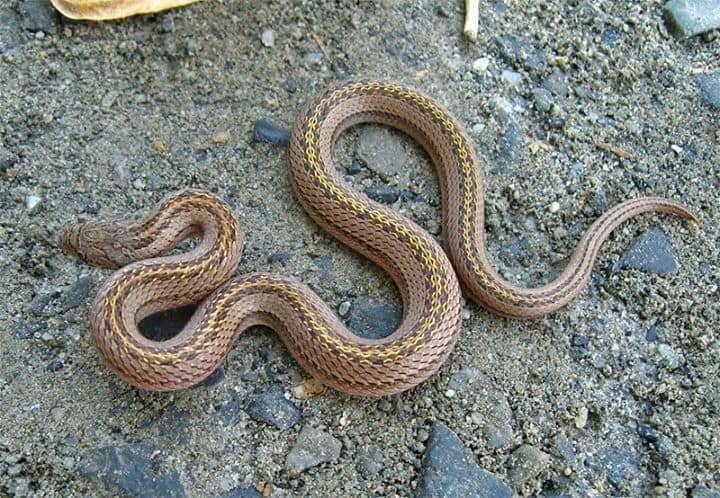
This southeast Asian snake ditches the vivid blue and uses a completely different warning system: a bright red tail underside. Striped kukri snakes are common in Thailand, Cambodia and Vietnam, where they inhabit lowland forests, gardens and plantations, sticking to the ground. They lack venom, but have brutally sharp fangs, which are optimised for reptile eggs and equally effective at slashing through a predator’s skin (or human’s) when picked up.
This is a seemingly humble snake with a secret weapon. That said, striped kukri snakes would rather not be picked up at all, and their strategy is waving their bright red tail underside rhythmically, to guarantee that predators notice it. How often this works is a mystery; maybe it depends on how cowardly individual birds are. This red tail contrasts sharply, as striped kukri snakes are mainly dull brown, with a lighter stripe down their spine.
Many aspects of this deception are unresearched, as it’s even possible that the wiggling rhythm affects success rates. A stationary red tail may not scare birds as effectively as a hypnotising, mesmerising one. Speed may also be involved. Don’t expect a study on this anytime soon, as the world contains thousands of poorly researched snake species, but you never know.
| 8 | Hagen’s pitviper |
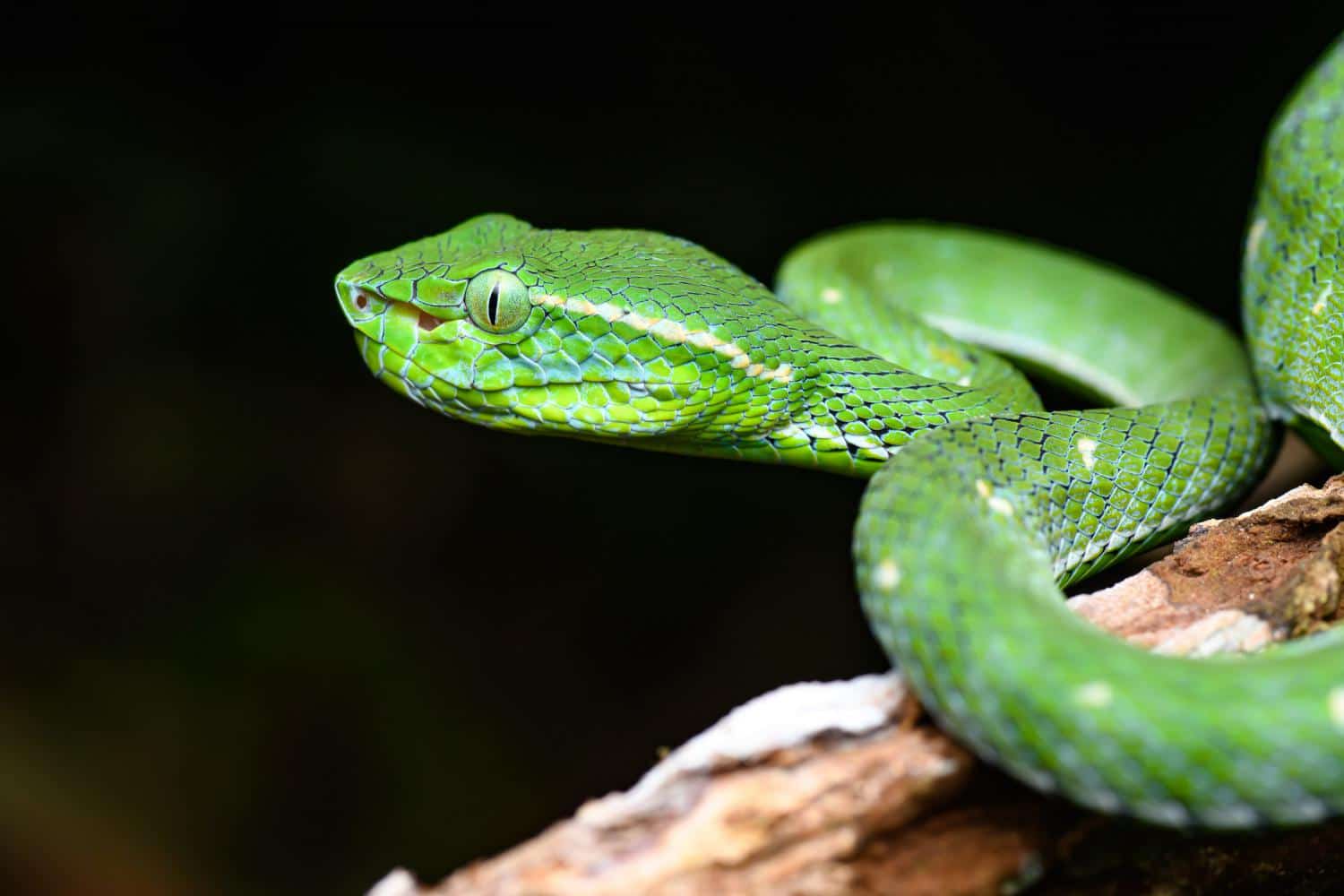
A 80-100cm snake of far southern Thailand, peninsular Malaysia, and Sumatra. This species lives in jungle branches and has a venom containing 216 proteins. There’s almost as many colours, as Hagen’s pitviper begins with the jungle green typical for Trimeresurus pitvipers. They have an electric blue upper lip, and a white line along their flanks. Between their scales, they have silky black skin which they can show off at will.
Trimeresurus hageni enjoys the best of both worlds. In foliage, they have a complete cloak of camouflage, with a leafy green so all-consuming that it covers their eyes. At a distance, they’re virtually impossible to spot. But when cornered, they use their blue, white and black to create a shocking display of colours. No sane human being would stroke a wild Hagen’s pitviper.
The physical characteristics of a venomous snake aren’t taught in school, but are somehow universal. An adult Hagen’s pitviper looks venomously radioactive, as though every cell is pulsing with poison. In reality, Hagen’s pitvipers rarely kill, but have a nasty venom rich in metalloproteinases, which causes necrosis and swelling of skin tissue surrounding the bite site.
| 9 | Spotted harlequin snake |
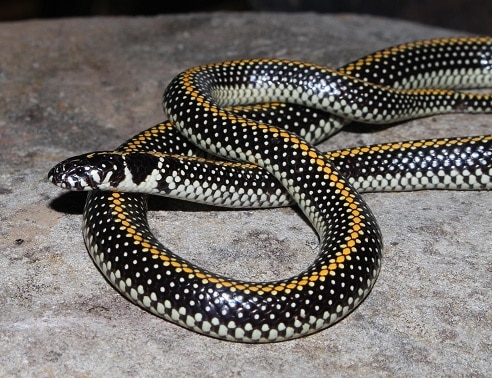
The spotted harlequin snake of South Africa has a paintbox of bright colours. Some are yellow spotted, others have a bright red spinal stripe, but they’re always colourful. This is a mildly venomous species, capable of swelling a finger up but not killing. They measure just 40-50cm, making them vulnerable to predators, but their neon colours may be a defensive tactic, taking advantage of an instinctive fear among some predators.
It’s easy to imagine how the change would have spiralled out of control, using good old fashioned natural selection. The ancestor of the spotted harlequin snake 20 million years ago may have been far duller, but had its own ancestor 20 million years earlier with brighter colours. If the dull version had a rare mutation, a morph where the old colour genes were switched back on, that freak snake could have had a sudden survival advantage, which the older ancestor didn’t have, perhaps if local birds had grown more fearful of bright colours in the 20 million years inbetween.
The freak morph would have a sudden survival shield and pass on its genes, which would spread and spread, until 100,000s of years later, the entire species became bright and colourful. This is all just wild speculation, but there are species today which are “inbetween”, like the brown kukri snake of Singapore, which is split evenly between a dull brown morph and a brighter red one. Maybe this species is in the middle of this transformation process. All it would take is for bright warning colours to become more advantageous than camouflage. Striped harlequin snakes prefer moister areas of South Africa, like grassland, moist savannah and lowland forest.
| 10 | Red-headed krait |
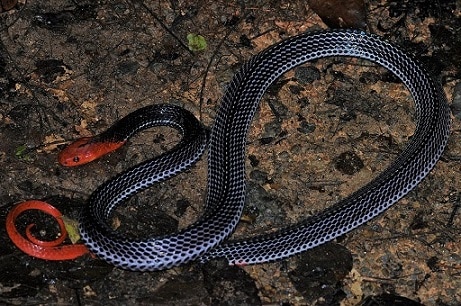
A venomous species of southern Thailand, peninsular Malaysia and Java. Red-headed kraits have a dark blue body, contrasting sharply against a red head. They live in moist forests and are rarely sighted by ordinary people.
Red-headed kraits can trigger paralysis and respiratory failure, or on a weaker level, laboured breathing and weak muscles. 56.2% of its venom is the infamous bungarotoxin-2. A red-headed krait’s head stands out clearly, even at night when they’re most active. They’re hoping to scare predators away, but this time, red-headed kraits are serious in what they say.
Like a red traffic light, it’s an instruction to freeze and not come an inch closer. They’re saying that if you touch this head, your inevitable fate is 100mg of neurotoxic venom flowing through your bloodstream, with millions of molecules distributing to every muscle receptor, and physically preventing brain signals from binding. A Thai species which isn’t serious is the pink-headed reed snake, which has a similar colour scheme, but is non-venomous. A red-headed krait bite can easily prove fatal, and there’s no specific antivenom.
